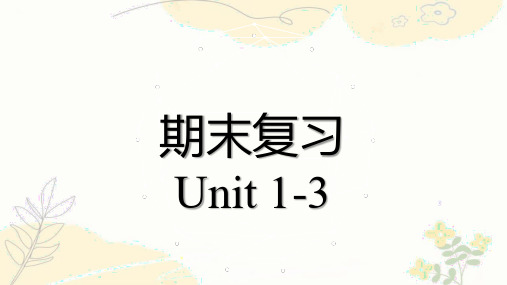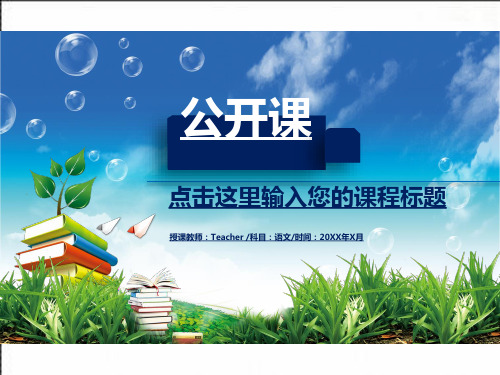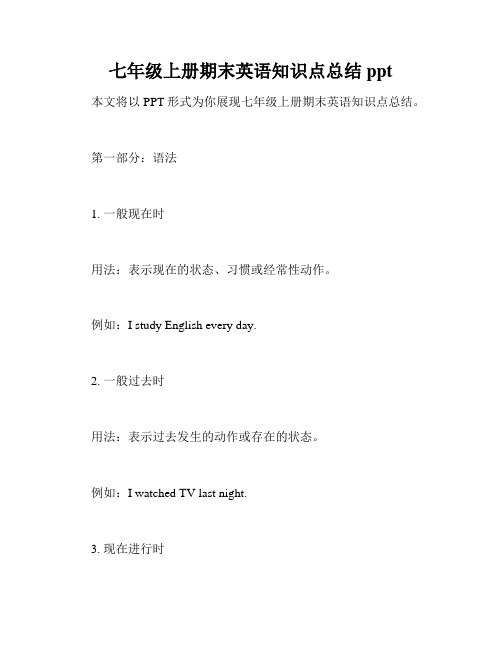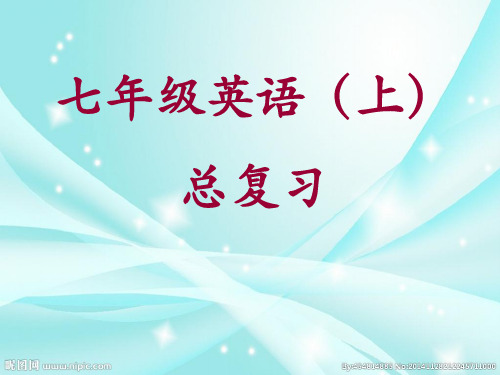七年级上册英语期末复习PPT课件
秋新目标七年级英语上册期末复习PPT

Evaluating the credibility, accuracy, and validity of the information presente explanation
Provide a range of multiple-choice questions to test comprehension.
Multiple-choice questions
Ask students to provide short responses to specific questions or tasks.
Short answer questions
Provide sentences with missing information and ask students to fill in the gaps.
Excellent sample article display
Listening Review
05
The ability to understand and interpret the information heard in English. This includes understanding the main idea, details, and the speaker's attitude or intention.
1
2
3
Introduce new words that are closely related to the learned vocabulary.
New Vocabulary Introduction
Learn synonyms and antonyms of the learned vocabulary to expand knowledge.
七年级上新目标英语期末复习 PPT课件 人教版

D 8. A. desk B. pencil C. bell D. evening C 9. A. go B. no C. not D. phone A 10. A. great B. please C. read D. teacher
ABC基础知识 BBC英国广播公司
B.C.公元前 CBC加拿大广播公司
P停车
CAAC中国民航
ID身份
DDD国内长途直拨
B黑度
IDD国际长途直拨
CD光盘
CBA中国篮球协会
IT信息技术 DJ音乐节目主持人
PC个人电脑 PRC中华人民共和国
常见字母缩写词
IQ智商
EQ情商
MBA工商管理学硕士 W.C.洗手间
•
63、彩虹风雨后,成功细节中。
•
64、有些事你是绕不过去的,你现在逃避,你以后就会话十倍的精力去面对。
•
65、只要有信心,就能在信念中行走。
•
66、每天告诉自己一次,我真的很不错。
•
67、心中有理想 再累也快乐
•
68、发光并非太阳的专利,你也可以发光。
--What’s this in English ? --It’s a key/ an orange. --Spell it, please . --K-E-Y. --What color is it ? --It’s green.
冠词a,an的用法
a 用在辅音音素开头的单数可数名词前, an用在元音音素开头的单数名词前。如 果名词前有修饰语,则以其第一个因素 是元音还是辅音而决定用a或an.
新目标人教版七年级上册英语期末考点复习ppt课件共50张ppt

胆道疾病病人护理化工企业本质安全 理论实 践及方 法内科 护理学 呼吸系 统总论 概论脾 胃病常 见症状 及治疗 经验偏 瘫截瘫 康复训 练手册 偏执性 精神障 碍品管 圈实践
胆道疾病病人护理化工企业本质安全 理论实 践及方 法内科 护理学 呼吸系 统总论 概论脾 胃病常 见症状 及治疗 经验偏 瘫截瘫 康复训 练手册 偏执性 精神障 碍品管 圈实践
胆道疾病病人护理化工企业本质安全 理论实 践及方 法内科 护理学 呼吸系 统总论 概论脾 胃病常 见症状 及治疗 经验偏 瘫截瘫 康复训 练手册 偏执性 精神障 碍品管 圈实践
胆道疾病病人护理化工企业本质安全 理论实 践及方 法内科 护理学 呼吸系 统总论 概论脾 胃病常 见症状 及治疗 经验偏 瘫截瘫 康复训 练手册 偏执性 精神障 碍品管 圈实践
胆道疾病病人护理化工企业本质安全 理论实 践及方 法内科 护理学 呼吸系 统总论 概论脾 胃病常 见症状 及治疗 经验偏 瘫截瘫 康复训 练手册 偏执性 精神障 碍品管 圈实践
胆道疾病病人护理化工企业本质安全 理论实 践及方 法内科 护理学 呼吸系 统总论 概论脾 胃病常 见症状 及治疗 经验偏 瘫截瘫 康复训 练手册 偏执性 精神障 碍品管 圈实践
胆道疾病病人护理化工企业本质安全 理论实 践及方 法内科 护理学 呼吸系 统总论 概论脾 胃病常 见症状 及治疗 经验偏 瘫截瘫 康复训 练手册 偏执性 精神障 碍品管 圈实践
胆道疾病病人护理化工企业本质安全 理论实 践及方 法内科 护理学 呼吸系 统总论 概论脾 胃病常 见症状 及治疗 经验偏 瘫截瘫 康复训 练手册 偏执性 精神障 碍品管 圈实践
胆道疾病病人护理化工企业本质安全 理论实 践及方 法内科 护理学 呼吸系 统总论 概论脾 胃病常 见症状 及治疗 经验偏 瘫截瘫 康复训 练手册 偏执性 精神障 碍品管 圈实践
七年级上册英语 Unit 1-Unit 3 复习课件人教版

复习目标
1.熟练掌握本单元的重点词汇和句型。 2.可以使用英文介绍自己也可以和别人打招呼。 3.掌握语法:一般现在时的用法、形容词性物主代词的用法。
4.通过本单元内容能与同学之间进行一个简单的交流。
1
Unit1 My name’s Gina
01
Key words
CONTENTS
她的电话号码是多少?
W____h_a__t_’_s___ ___h_i_s______t_e_le__p__h_o__n__e__ __n_u__m___b__e_r_?
他的电话号码是多少?
Sentences
2._W____h_a__t_’_s__ _h__i_s________ _I__D_________ _n_u__m___b__e_r__ ?
你的名字
他的名字 她的名字 我的名字
Phrase
telephone number = phone number first name = given name last name = family name ID card
电话号码
名字 姓氏 身份证
Phrase
middle school my friend in China
肯定
I am =I'm we/you/they are= we're/ you're/they're he/she/it is= he's/ she's / it's
否定
I am not = I'm not(am not 不能缩写) we are not = we aren't;you are not = you aren't ; they are not = they aren't
人教版七年级英语上册期末总复习课件PPT

这里输入您的文本 这里输入您的文本
您的文本 您的文本
这里输入您的文本 这里输入您的文本
这里输入您的文本
这里输入您的文本
点击这里输入您的标题
输入您的文本
输入您的文本
输入您的文本
这里输入您的文本这里
这里输入您的文本这里输
这里输入您的文本这里
输入您的文本这里输入
入您的文本这里输入您的
输入您的文本这里输入
单击这里输入内容,单击这里输入内容
单击这里输入内容,单击这里输入内容
点击这里输入您的标题
您的文本内容
您的文本内容
您的文本内容 您的文本内容
点击这里输入您的标题
您的 文本
您的 文本
您的 文本
您的 文本
这里输入你的文本内容这 里输入你的文本
这里输入你的文本内容这 里输入你的文本
这里输入你的文本内容这里 输入你的文本
您
的
• 在此添加标题或目录索引
文 您
• 在此添加标题或目录索引
本
的
• 在此添加标题或目录索引
文
• 在此添加标题或目录索引
本
您
• 在此添加标题或目录索引
的
• 在此添加标题或目录索引
文
本
点击这里输入您的标题
单击添加标题
点击添加文本
单击此处输入标题文字
填加文字
填加 标题
填加文字
单击添加标题 点击添加文本
章节
5 这里输入您的标题五
点击这里输入您的标题
01 02 03 04
某某方面: 这里输入你的文本内容这里输入你的文本内容这里输 入 某你某的方文面本:内容这里输入你的文本内容你的文本内容 这里输入你的文本内容这里输入你的文本内容这里输 入 某你某的方文面本:内容这里输入你的文本内容你的文本内容 这里输入你的文本内容这里输入你的文本内容这里输 入 某你 某方的面文:本内容这里输入你的文本内容你的文本内容 这里输入你的文本内容这里输入你的文本内容这里输 入你的文本内容这里输入你的文本内容你的文本内容
七年级上册期末英语知识点总结ppt

七年级上册期末英语知识点总结ppt本文将以PPT形式为你展现七年级上册期末英语知识点总结。
第一部分:语法1. 一般现在时用法:表示现在的状态、习惯或经常性动作。
例如:I study English every day.2. 一般过去时用法:表示过去发生的动作或存在的状态。
例如:I watched TV last night.3. 现在进行时用法:表示现在正在进行的动作。
例如:She is singing a song.4. 一般将来时用法:表示将来的动作或存在的状态。
例如:I will go to the cinema tomorrow.第二部分:词汇1. 数字基数词和序数词例如:one, first; two, second; three, third 2. 颜色常见颜色的英文例如:red, blue, yellow, green, black, white 3. 学科常见学科名称的英文例如:math, English, geography, history 4. 动物常见动物名称的英文例如:dog, cat, bird, fish, monkey第三部分:口语1. 问候与自我介绍常用问候语例如:Hello, Hi, Good morning/afternoon/evening, How are you?自我介绍要素例如:姓名、年龄、国籍、家庭成员、喜好等2. 购物常见购物用语例如:How much is it? Can I have a discount? I would like to buy this one.3. 约定常用约定用语例如:When and where shall we meet? Shall we go together? What time should I arrive?第四部分:听力1. 听力技巧①注意听力材料的标题与日期②记录答案时要注意大小写和拼写③确定答案前要听完整个录音2. 听力练习可以利用听力材料进行针对性练习。
最新人教版七年级英语上册全册复习ppt课件

uncle+aunt cousin
询问家庭
--How many people are there in your family?
--There are 4 people in my family.
-Who is he? -He is my father. -Who is she? -She is my mother. -Who are they? -They are my parents.
一、翻译
1. 我父母 ___________ 2.它名字 ________ 3.他的姓氏_____________ 4.你可以________ 5.你的电话号码___________ 6.帮助她________ 7. 他有_______ 8.我们想要__________ 9.看见它____________ 10. 它吃_______ 11.我们最喜爱的水果__________ 12.他们旧电脑____________ 13.她全家照_____________ 14.join _______(我们) 15. 谢谢你。 _________ 16.她喜欢它。 ____________
/u:/ Qq Uu Ww /aɪ/ Ii Yy /a:/ Rr /əʊ/ Oo
字 母 按 元 音 因 素 分 类 表
ad广告 g克 kg千克 S小号 M中号 L大号 mg毫克 m米 cm厘米 mm毫米 ml毫升 a.m.上午 p.m.下午 IQ智商 EQ情商 UK英国 USA美国 UN联合国 HK香港 PRC中华人民共和国 A.D.公元 B.C.公元前 W.C.洗手间 MTV音乐电视 DJ音乐节目主持人 CCTV中国中央电视台 P停车 OK好吧 ID身份 HB硬黑 CD光盘 P.E.体育 UFO不明飞行物 ABC基础知识 PC个人电脑 TV电视 IT信息技术 SARS非典型性肺炎 NBA美国篮球联赛 CBA中国篮球协会 BBC英国广播公司 WTO世贸组织 SOS国际求救信号 WHO世界卫生组织
七年级英语上册全部复习ppt课件

词汇区别:
1) picture & photo 不同点:photo 照片 picture 图画 相同点:
2)后加动名词;
例如:Thanks for helping me. Thank you for helping me.
4、Here is my family photo.
倒装句:
如果出现副词here, there 位于句首时句子常用倒装形 式。
1)如果主语是名词,则完全倒装; Here + 系动词+ 名词 例如: Here is a book.
5、the的用法 1) 特指某些人或某些物; 2) 用于谈话双方都知道的名词前; 3) 用于第二次提到的人或物的名词前; 4) 用于表示独一无二的名词前; 5) 用于江、河、湖、海、山、岛的名词前; 6) 用于西洋乐器名词前; 7) 用于姓氏复数形式之前,表示某一家人; 8) 用于在序数词前和形容词的最高级前; 9) 和某些形容词进行连用表示一类人;(The old) 10)用在固定搭配中 in the end; by the way; in the morning
Unit 3: Is this your pencil?
New Words.
this pencil pen book eraser ruler case pencil case backpack pencil sharpener stationary that yes no not excuse thank OK in English
Unit 2: This is my sister.
人教版七年级英语上期末总复习课件详细

❖ Ms. ❖ zero ❖ one
❖ two
❖ three
❖ four ❖ five ❖ six
❖ seven
女士
0 1 2
3
4 5
6 7
❖ eight
8
❖ nine
9
❖ telephone
电话号码
பைடு நூலகம்
number=phone number
❖ in China
在中国
❖ first
❖ last
['ɡræn,fɑ:ðə]
grandfather祖父,外祖父 汇
['ɡræn,pεərənt] grandparent祖父(母)
['fæmili] [huː] [ðəuz] [ðei, ] [ði:z]
[wel]
family 家庭;家族; who 谁
those 那些
they 他们;它们;她们 these这些 well 好吧
Exercises
❖ I’m Linda.(改为同义句) ❖ _M_y_ _n_a_m_e’s Linda. ❖ My name is Tony Brown.(对画线部分提问)
❖W_h_a_t’s _y_o_u_r name? ❖ She is Mary Smith.一(改为般疑问句)
❖ _I_s__ _s_h_e_ Mary Smith?
❖ My favorite color is…
❖ This is me.
第十二页,共186页。
书写规则:
1)句子开头的一个字母必须要大写; 2)人名的开头一个字母必须大写; 3)句末要用上正确的标点符号; 4)英语的句号是小圆点而不是小圆圈; 5)单词与单词之间要间隔一个字母的距 离。
人教版七年级英语上册 Unit 2 期末复习 习题教学课件PPT初一公开课

英语·人教版·七年级上册UNIT 2 This is my sister.section A第1题图 第2题图 第3题图 第4题图 第5题图答案1.This is my b . He is very lovely(可爱的).2.This is Alice. She is my s .3.—Are these your p , Ann? —Yes, they are.4.Li Juan's g is in Shanghai.5.—Is he your f ? —Yes, he is.一、词汇运用(A)根据图片和首字母提示写出单词1.brother2.sister3.parents4.grandmother5.father(B)根据汉语或首字母提示写出单词6.— (谁) is the boy with a pair of glasses(眼镜)?—He's Frank.7. (这些)are my friends, Mike and Frank.8.My father is the only(唯一的) son(儿子) of my (祖父母).9.There are seven d in a week(周).10.I love my father and mother. I love my f .答案6.Who ——那个戴眼镜的男孩是谁?——他是弗兰克。
根据答语可知,此处问的是人,故用Who。
7.These 句意:这些是我的朋友们,迈克和弗兰克。
8.grandparents 句意:我爸爸是我祖父母唯一的儿子。
表示祖父母两个人应用grandparents。
9.days 句意:一星期有七天。
day为可数名词,前面有seven修饰,故用其复数形式days。
10.family 句意:我爱我的爸爸妈妈。
我爱我的家。
二、根据汉语意思完成句子(每空一词)1.这是我的爸爸。
他是一名医生。
人教版七年级英语上期末总复习课件详细

To focus on specific topics or skills that students have struggled with or need extra practice in.
Exam-focused review
To provide exam-focused review materials and strategies, including past exam papers and detailed analysis of exam formats and question types.
02
Vocabulary and Grammar Review
vocabulary review
词汇复习
复习七年级英语课程中学习的所有词汇,包括名词、动词、形容词、副词等各类 词性,以及常用短语和习惯用语。通过例句和练习题加深记忆和理解。
Grammar Review
语法复习
系统回顾七年级英语课程中的语法知识,包括时态、语态、虚拟语气、非谓语动词等。通过例句解析和练习题巩固语法规则 ,提高语言运用能力。
Reading skill
Reading strategy
Teach students how to use reading strategies, such as skimming, scanning, and predicting, to improve their reading efficiency and comprehension.
期末Units1-2单元复习课件人教版七年级英语上册

5.她的QQ号码是819144533。 _H_e_r_Q__Q__n_u_m__b_e_r_i_s_8_1_9_1_4_4_5_3_3_._____________________
背记作文基本句型
请你Unit 2所学的句子,完成下面的句子。 1. 这是我的爸爸。
Unit 1-Unit 2单词重点记忆(写作词汇)
单元话题短语积累
1.他的姓 his last name
2.电话号码 telephone/phone number
3.她的名字 her name
4.中学
middle school
5.你的朋友 your friend
6.在中国 in China
Unit 1-Unit 2单词重点记忆(写作词汇)
1
Units 1-2复习课件
七年级上册
Contents
Unit 1-Unit 2单词重点记忆 Unit 1-Unit 2重点句子背诵 背记作文基本句型 作文实战训练
Unit 1-Unit 2单词重点记忆(拓展词汇)
1.good(adj.) → well (adv.) 2.see(v.)→ saw (过去式)→ seen (过去分词) 3.can → could (过去式) 4.say(v.)→said (过去式)→ said (过去分词) 5.China(n.) → Chinese (adj.) 6.family(n.)→ families (复数) 7.dictionary(n.)→ dictionaries (复数)
Unit 1-Unit 2(15个)重点句子背诵
七年级上册英语期末总复习.ppt

LISTEN AND SING THE ALPHABET SONG.
A, B, C, D, E, F, G, H, I, J, K, L, M, N, O, P, Q,R
U, V, W, X, Y, Z. X, Y, Z,now you see, I can say my ABCs.
Starter unit 3 4b
On “在…上面”,通常两个物体表面有接触; 在具体的某天 ,星期几
on Monday /on May 2nd In “在(一个场所、位置或空间的)里面”
颜色的前面 in red 在年月早晚 in August /in the morning at 在几点 at three 3:00 under“在…下方”,这两个物体表面不接触;
bring指由远而近地把人或物带来、拿来或送来。 Can you bring some things to school?
你能把你的录像带带来学校吗?
take指由近而远地把人或物带去某处。 Please take these books to Peter.
请把这些书带给彼得。
Unit 5
basketball soccer ball
定冠词 the
(1)特指 The book on the desk is mine. (2)双方都知道的 What’s the new teacher’s name? (3)指上文提到 He lives on a farm. The farm is not big (4)世上独一无二的 The sun ,the moon, (5)国家、河山专有名词前the Great Wall The Yellow River (6)姓名复数形式前表一家人 The Smiths (7)某些习惯用语 in the morning, on the left, 注:名词前已有作定语的this、that、my、your等限定词时 不用冠词的情况 My brother is a student.
七年级上册英语期末知识点总结ppt

七年级上册英语期末知识点总结ppt 在初中英语学习中,期末考试是非常重要的一环,因为期末考试成绩直接影响到学生的学业发展。
为了帮助七年级学生复习英语知识点,本文总结了七年级上册英语期末知识点,并以PPT的形式呈现。
一、名词名词是一个句子中最基本的组成部分之一,它通常指代事物、人物、地点等具有实际存在意义的东西。
在名词的使用中,需要注意单复数形式的转换,不同名词的意思和用法也需要学生进行区分。
二、代词代词是替换其他名词或代词的词语,例如:I, you, he, she, it, they等。
在代词的使用中,需要注意主格、宾格、形容词性物主代词和名词性物主代词的使用。
三、动词动词是句子中最重要的成分之一,表示行为、状态、变化等意义。
在动词的使用中,需要注意动词的时态、语态、情态动词的使用和动词的不规则变化形式等。
四、形容词和副词形容词和副词是用来修饰名词和动词的词语。
在形容词和副词的使用中,需要注意形容词和副词的比较级和最高级的用法和变化形式。
五、介词和介词短语介词是用来连接名词或代词与其他词语的词语,它们常用于表达时间、地点、方式、目的等不同的语境。
在介词和介词短语的使用中,需要注意不同介词表达的意思和用法。
六、连词连词是用来连接句子或单词的词语,例如:and, but, or等。
在连词的使用中,需要注意不同连词的意思和用法以及使用时需要进行的主谓一致和时态一致等。
七、疑问词疑问词用于提出问题,例如:what, where, when, why, how等。
在疑问词的使用中,需要注意不同疑问词的意思和用法以及疑问句的语序和语调。
八、陈述句、祈使句和疑问句陈述句用于陈述事实,祈使句用于表达请求或要求,疑问句用于提问。
在不同句型的使用中,需要注意语序、语调和使用场合等。
以上就是七年级上册英语期末知识点的总结,通过PPT形式呈现,希望能够帮助学生复习英语知识点,取得好成绩。
- 1、下载文档前请自行甄别文档内容的完整性,平台不提供额外的编辑、内容补充、找答案等附加服务。
- 2、"仅部分预览"的文档,不可在线预览部分如存在完整性等问题,可反馈申请退款(可完整预览的文档不适用该条件!)。
- 3、如文档侵犯您的权益,请联系客服反馈,我们会尽快为您处理(人工客服工作时间:9:00-18:30)。
单项选择
(D)1. —Can Mary play soccer? — .
A. Yes, she is
B. No, she doesn’t
C. Yes, she does D. No, she can’t
(C)2. I don’t a tennis racket, but Kate one.
你能把你的录像带带到学校吗?
take指由近而远地把人或物带往某处。 Please take these books to Peter.
请把这些书带给彼得。
Unit 5
▪ soccer 英式足球(运动) ▪ soccer ball 英式足球 ▪ tennis 网球 ▪ tennis racket 网球拍 ▪ ping-pong 乒乓球(运动) ▪ ping-pong ball 乒乓球 ▪ ping-pong bat 乒乓球拍 ▪ volleyball 排球 ▪ basketball 篮球
对于“Is this / that ...”的提问, 指照片上的人 物或其他不知性别的人物时, 可用it 来指代。
A. this和that的复数形式分别为these 和
B. those 。
B. 把某人介绍给他人时,常用 “This is ...” 句型, 其中this不能换成he或she。介绍 多个人物时要用 These are…。
it is = it’s What’s =what is I am= I’m
Unit 2
指示代词:This (这个)-- These That(那个)-- Those
This is his pencil sharpener.
That is her English dictionary.
Is this your pencil? Yes, it is. No, it isn’t.
Unit 4
Where’s the baseball? It’s in the backpack. Where’re my keys? They’re under the chair.
The backpacks are on the desk. The CDs are in the computer. The alarm clock is under the table. The books are behind the dresser. The girl is between the basketballs.
Is that her eraser? Yes, it is. No, it isn’t.
Lost and Found: 失物招领
---How do you spell “watch”? ---W-A-T-C-H
Please call John at 035-7328. 请打找约翰。
They call me Tina. 他们叫我蒂娜。
Unit 1
First name
My name is Allan Green.
Last name= Family name His Chinese name is Zhang Mingming.
First name
telephone number=phone number
What’s your telephone number? My telephone number is 856-6581 It is /It’s 856-6581
本单元我们学习了介词:in, on, under。
这些表示处所或者位置的介词常和名词搭配 构成短语。需要特别注意的是:
on表示“在……上面”,通常两个物体表面有 接触;
under表示“在……正下方”,通常这两个物 体表面不接触;
in表示“在(一个场所、位置或空间的)里 面”。
bring指由远而近地把人或物带来、拿来或送来。 Can you bring some things to school?
That sounds interesting. 那听起来很有趣。
sound意为“听起来”时, 后面常接形容 词。
此外, sound后还可接名词短语。 That sounds a good idea.
那听起来是个好主意。
Language points
play 玩;打(球) Do you play volleyball? 你打排球吗? I can play the piano. 我会弹钢琴。 play和球类运动的名称连用时,球类运动的名称前 不用冠词。
aunt uncle mother father uncle aunt
cousin cousin
I brother
cousin
—Is this / that your sister? —这/那位是你的姐姐吗?
this、 that为指示代词, 当涉及辨认近处和远 处的人或物体时, 近处用this, 远处用that。
She doesn’t have a computer game. 3. Do you have a baseball? (否定回答)
No, I don’t . 4. The balls are in the dresser. (划线提问)
Where are the balls? 5. Does he play sports every day? (肯定回答)
在be动词引起的一般疑问句中,be动词的形 式由主语决定。 当主语为第三人称单数时,谓语用单数is; 当主语为第二人称或其他复数人称时,be动 词用are; 当主语为I时,be动词用am。
注意:am和not不能缩写。
Unit 3
My family
grandmother grandfather grandfather grandmother
play和乐器名称连用时,乐器名称前一般要用定冠 词the。 链接: play computer games 玩电脑游戏
play sports 参加体育运动或比赛
Байду номын сангаас
句型转换 1. He has a tennis racket. (一般疑问句)
Does he have a tennis racket? 2. She has a computer game. (否定句)
